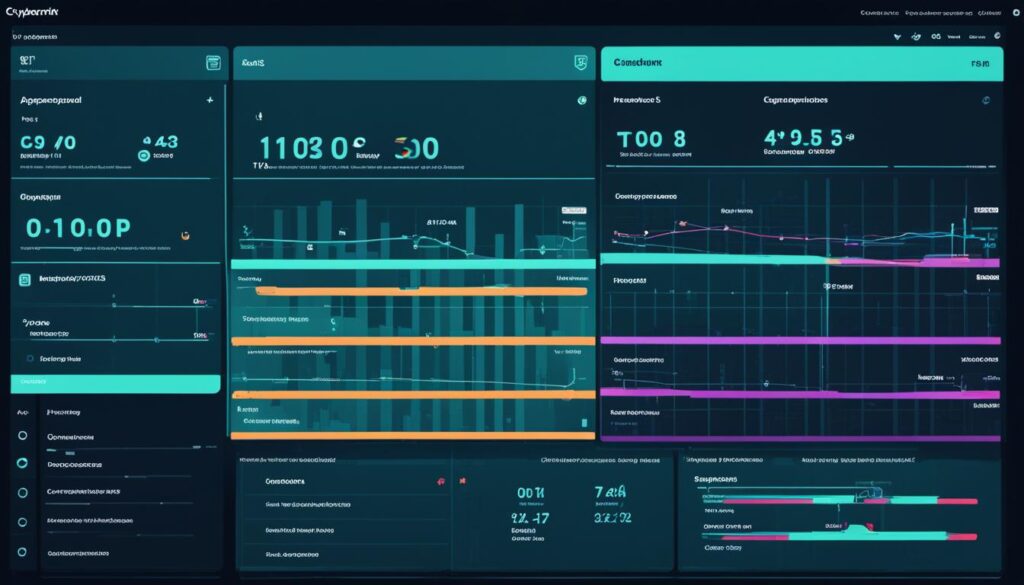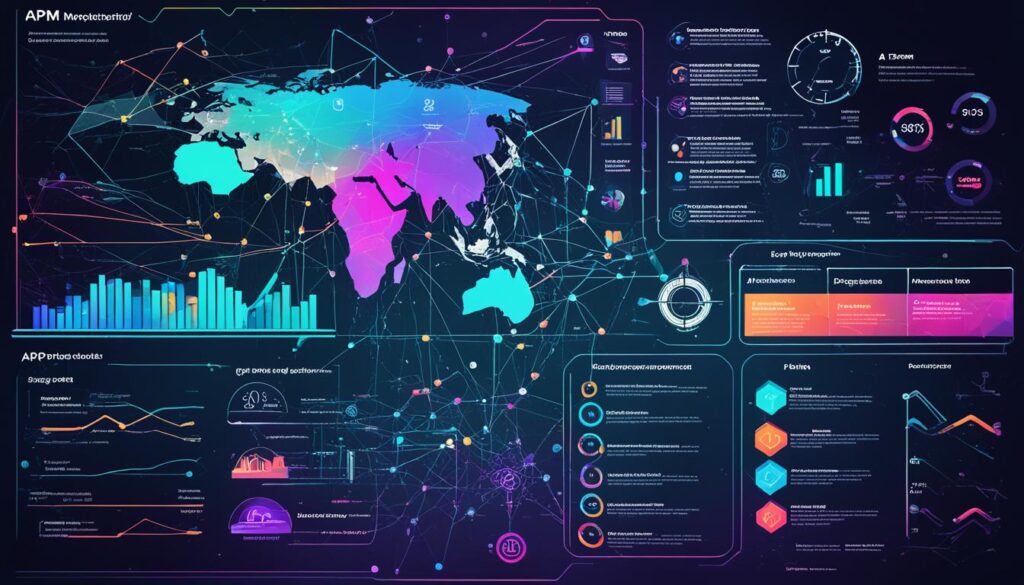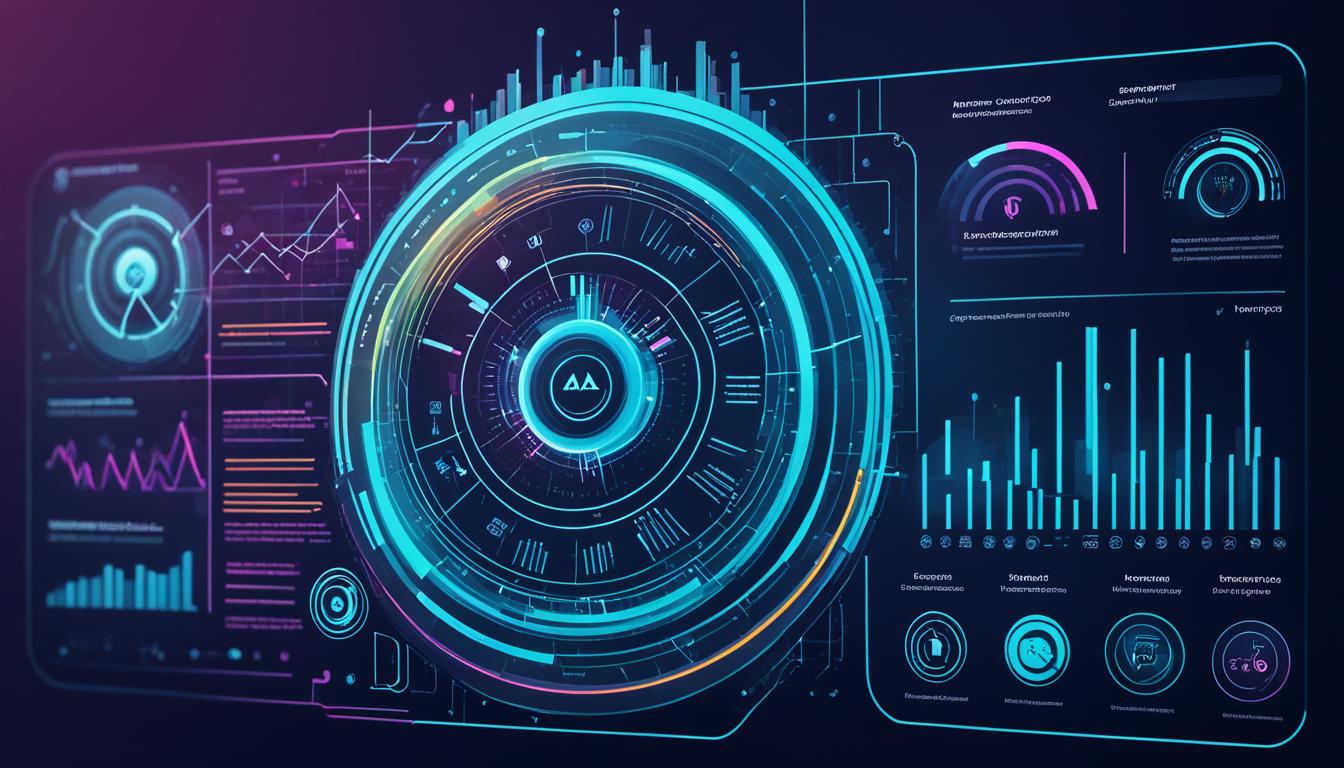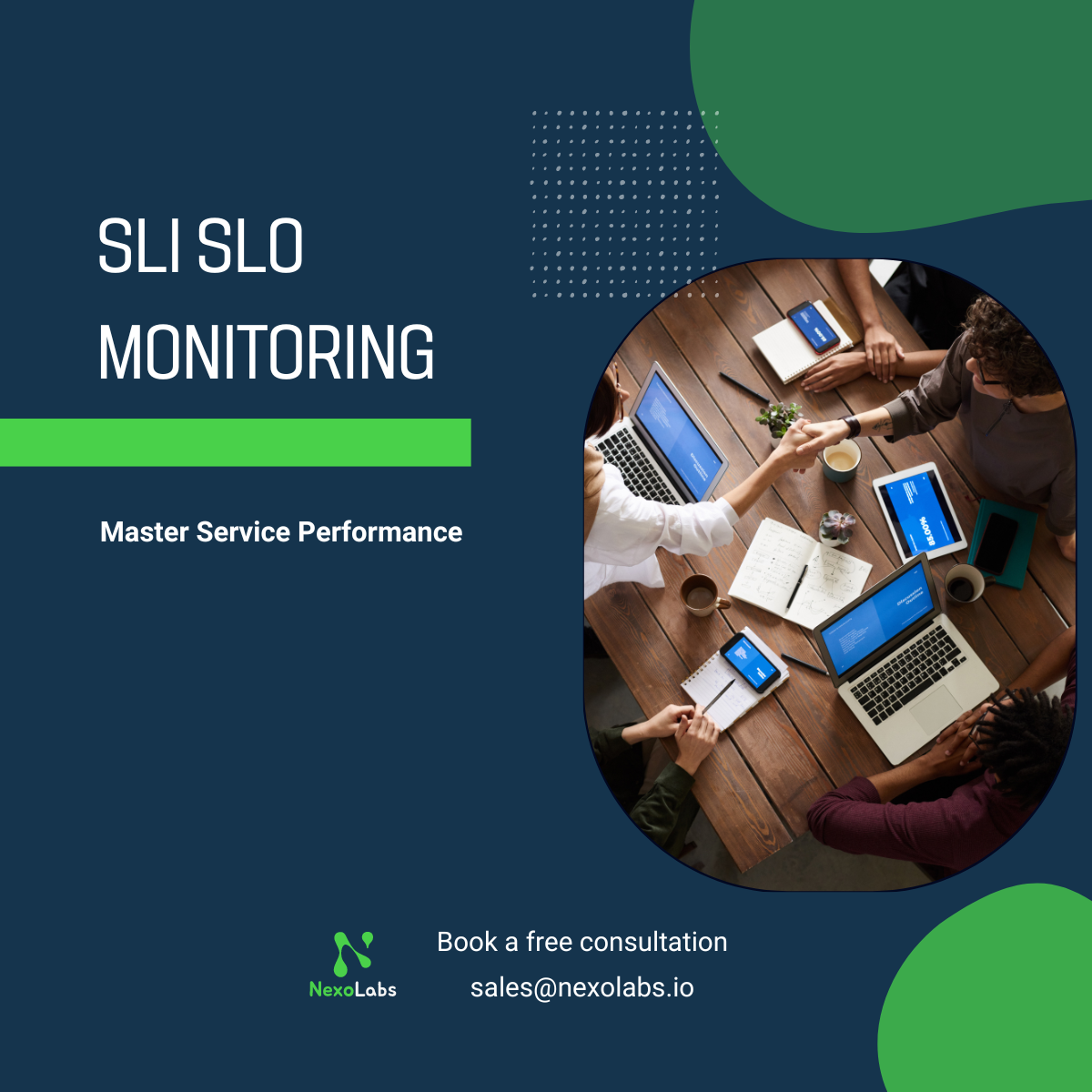Software applications are more complex than before. APM in DevOps is cruisual This makes application performance monitoring (APM) very important. How can APM be used to find and fix issues before users are affected? This article digs deep into Application Performance Monitoring, covering what it is, its parts, and how it helps modern software work and stay efficient.1
We’ll look at different APM types and the tools used. We’ll also see the important measures needed to keep applications running smoothly. You’ll read about case studies where APM made a big difference and learn about the future of APM.1
Key Takeaways
- APM gives a live look at how applications act. This lets teams find and fix issues before users notice.2
- APM tools collect data on things like how fast an app responds, how many errors there are, and how much of the computer’s resources it uses. This info is vital for planning future needs.3
- Mixing APM with DevOps makes monitoring continuous, tests happen automatically, and apps run their best.3
- APM tools provide clear sight, real-time checks, are easy to use, and quickly alert about issues. This helps businesses keep their apps running well.2
- When APM is done right, users are happier, lost sales from downtime drop, and cloud costs get under control. It all comes from understanding how apps perform.2
Introduction to Application Performance Monitoring (APM)
Application Performance Monitoring (APM) means keeping an eye on software apps’ performance and making sure they’re available. It’s all about watching how apps work, analyzing the data, and spotting any problems. This way, we help make sure that everything runs smoothly for users.4 APM tools give us a peek into how apps are doing in real-time. This helps teams fix issues before users notice them.5
What is APM?
APM is looking after how well software apps perform. It uses many tools to check on various stats and signs, telling us about the app’s health.4 These tools help developers and ops teams find and solve issues, keeping the app running well.6
The Growing Need for APM
Software today is becoming more complex, making APM more important than ever.5 With lots of data from apps that run on the cloud, we face new challenges in keeping apps fast and reliable.4 APM lets us stay ahead, fixing problems before users even notice.5
Benefits of APM
APM offers many upsides. It makes apps more stable, cuts down on issues, and helps solve problems faster. Also, it means apps are better when they’re updated.
It helps in other ways too, like making users happier and boosting profits. APM also cuts costs, and it makes working together easier and more productive. By using APM tech that uses AI and machine learning, we can even predict and fix issues before they happen.5
Key Components of APM
Effective Application Performance Monitoring (APM) helps us see what’s going on in our apps. It looks at how the app behaves and performs.6
Metrics and Data Collection
APM tools keep an eye on things like response time and error rates. They do this to understand how well the app is doing.6
They also look at how users feel when they use the app. This is checked by looking at what users do in the app and how fast pages load. Making sure users are happy is important.6
Real-Time Monitoring
APM tools are great at watching the app’s performance in real-time. They look at many different parts of the app to understand its health.3
If something is wrong, APM tools can send a quick alert to the team. This helps fix problems fast. They also keep a record of how the app has been doing over time. This is useful to spot any ongoing issues.3
Alerting and Reporting
These tools are also good at spotting issues early on. They do this by checking for errors and unusual behavior. Finding and fixing issues before users notice is key.6
APM can dig deep into the app’s code. This helps developers fix issues right at the root. It also checks how well the app can grow without losing quality. This is important for planning the app’s future.6
With these tools, companies can really understand their app’s health. This means they can fix problems before they get serious, use resources better, and make sure users have a great time.3
Types of Application Performance Monitoring
Application Performance Monitoring (APM) ensures software runs well. It looks at many parts of applications. Organizations use different APM types to see and control their app systems well.
Web Application Performance Monitoring
Monitoring web apps checks how well they work. It tracks apps like e-commerce sites and news portals.7
7 Synthetic monitoring finds issues early. This cuts problems after apps are live.7 With agentless monitoring, you can check network traffic yet not disturb apps. This saves time.7 Plus, user-defined tracking helps fix app issues fast.
Infrastructure Monitoring
7 Monitoring components like servers watch over an app’s health. This gives a full look at how apps perform.7 Monitoring infrastructure includes servers and databases. It helps find and fix app problems fast.
Database Monitoring
Monitoring databases is key for APM. It looks at how databases affect apps. This includes watching query times and fixing errors.7 Tracking databases helps make apps run smoother for users.
4 APM’s key features are discovering apps and their parts in real time. It looks at everything to make apps work better.4 Using AI, APM tools deeply analyze app performance to keep things running well.
Popular APM Tools
The APM market is full of tools with diverse features. Each tool aims to meet different organization needs. Here’s a look at some top APM tools:
Datadog
Datadog is in the cloud and offers detailed monitoring and analytics. It tackles apps, infrastructure, and cloud areas. With real-time tracking, app tracing, and AI for spotting issues fast, it’s very helpful.8
New Relic
New Relic stands out for app, infrastructure, and user experience monitoring. It gives a deep look into app performance, offers diagnostics at code-level, and helps optimize SQL queries. Those wanting better app reliability and user experience often choose New Relic.89
Dynatrace
Dynatrace uses AI to really dig into app performance, infrastructure, and user experience. Its AI auto-finds and fixes performance problems. This is great for large, complex applications.9
Splunk
Splunk rocks as a data analytics platform and for APM. It analyzes tons of machine data, showing app behavior, system health, and user actions. Its adaptability fits varied monitoring needs well.8
ServiceNow
ServiceNow is in the cloud and focuses on managing IT services. It links app performance data with managing IT processes. This proactive approach, perfectly aligns with business goals, is good for complex IT settings.8

apm devops
APM DevOps combines app performance tools into the DevOps process. It makes sure applications work well all the time. This move enhances the entire lifespan of an app. By linking APM with DevOps, companies get many advantages:
Integrating APM with DevOps Workflows
3 APM tools check things like how much CPU a system is using or request speeds. This info helps plan resources better.8 APM also finds places in the app that might slow down or even stop the app. This way, developers and operations people work better together. They can speed up how apps are made.
You can learn more about our service here.
Continuous Monitoring and Feedback Loops
3 APM gives a clear picture of how an app is doing and where it might slow down. This helps find issues that affect the user’s experience.3With APM, DevOps teams can keep an eye on important stats to fix problems before users notice.3APM watches over apps all the time. It looks at many layers of the app to make the system work better.
Automating Performance Testing and Optimization
8 APM makes tests better and finds key issues. It helps with load testing.3 APM also helps spend wisely on cloud services. It shows how resources are used and helps manage costs better.

| Open-source APM Tools | Key Features |
|---|---|
| Apache SkyWalking | Distributed tracing, service mesh analysis, and incident analysis |
| Pinpoint | Application monitoring, transaction tracing, and profiling |
| JavaMelody | Java application monitoring, performance monitoring, and reporting |
| Stagemonitor | End-user monitoring, application performance monitoring, and root cause analysis |
| Site24X7 | Website and web application monitoring, server monitoring, and network monitoring |
| Storage Resource Manager | Storage performance monitoring, capacity planning, and reporting |
| New Relic APM | Application performance monitoring, infrastructure monitoring, and digital experience monitoring |
| Foglight | Database performance monitoring, server monitoring, and virtualization monitoring |
| Compuware APM | Application performance monitoring, mainframe monitoring, and user experience monitoring |
| BMC software APM | Application performance management, digital experience monitoring, and cloud monitoring |
8 APM helps improve how much money a business makes and offers a better experience to users.3It lets teams spot and fix issues before they are big. This way, systems work better, and users are happier.3APM is key for strong, dependable systems in DevOps settings and SRE strategies.
APM Metrics and Key Performance Indicators (KPIs)
Application Performance Monitoring uses many metrics and KPIs. It aims to keep applications working well and ensure users have a great experience. These metrics show how well software works and if it can handle more users. They let companies find and fix problems before users notice.10
Response Time
Knowing how fast a page loads is key.10 It helps spot what slows things down. Fixing these issues keeps the user experience smooth and fast.
Error Rates
Keeping an eye on error rates is crucial. It helps teams know what issues to fix first to make the app more reliable. APM tools look at errors and give early warning signs. This way, teams can solve problems before they bother users.10
User Satisfaction
The Apdex score shows how happy users are with a web app, from 1 to 0.11 Tracking this score helps teams know if they meet user needs. They can then work to keep improving.
Resource Utilization
Monitoring how much your app uses resources like CPU and memory is important. It ensures your app stays fast and doesn’t use too much. For instance, high CPU use for too long might mean you need a stronger server. High disk usage shows you might need to store your data better.10
APM tools also keep tabs on many other things, like if the app is available, how much traffic it gets, and more.10 This full picture helps teams understand and boost their app’s performance over time.

Challenges and Considerations in APM Implementation
Application performance monitoring (APM) brings many advantages. However, adopting APM solutions can be tough. Organizations must deal with app complexity, data security, and costs. They also need to think about the best way to use resources.12
Complexity of Modern Applications
The way we build apps has changed a lot with microservices, containers, and the cloud. This has made apps more complex. It’s hard to keep tabs on how well these systems are working together.13
Apps today use many different programming languages and databases. This adds another layer of difficulty for organizations trying to keep up with their performance.13
Data Privacy and Security Concerns
Because organizations gather huge amounts of data on app performance, they face data security worries. It’s crucial to meet privacy laws and keep data safe. These issues are key when implementing APM.13
Cost and Resource Allocation
Getting APM right is not easy and can use up a lot of resources. It needs money and the right people to work. Organizations have to carefully plan their spending on APM tools and know-how.12 Also, picking public cloud services, where APM tools often run, might change the budget. Companies might also need staff who can work with new tech easily.12
To tackle these challenges, organizations need a smart strategy for application performance monitoring. They need to balance the advantages APM brings with what their business and tech situations really need.
Best Practices in Application Performance Monitoring
To make the most of Application Performance Monitoring (APM), organizations need to follow key steps. These practices help achieve the best outcomes.
Establish Performance Baselines
First, set performance baselines for your apps before starting APM work. Look at past data to know what’s usual. You’ll set target levels for things like how fast the app responds, errors, and resource use.14 Looking at past resource use will help you plan for the future, spend your money wisely, and use resources better.14
Prioritize Critical Business Transactions
Find the most important business actions and the user paths that matter the most. Aim your APM work at these key areas to get the best app performance and user experience.15 A broad APM approach is key in finding and fixing problems that affect user satisfaction.15
Leverage Automation and Orchestration
Bring APM tools and steps into your DevOps to make performance work automatic. This includes testing, responding to issues, and making things run smoother.14 Tools that alert you are crucial. They can stop big problems, keep your app working, and make your users happy.1415 Automation in fixing issues quickly is also important during serious problems.15
Collaborate Across Teams
To do APM right, everyone needs to work together, from developers to operations. Make sure information flows freely and everyone is on the same page. Use shared tools and processes to act fast with the data you gather.15 Don’t forget to keep an eye on app availability, how fast it responds, errors, transactions, and resource use.15
By following these tips, organizations can use APM to spot and tackle performance problems early. This will let them make the best use of their app resources, and give users an amazing experience.
Case Studies and Success Stories
The advantages of APM are clear across many fields. Real cases show how APM helps.
E-commerce Platform Improves User Experience
A top e-commerce website had issues during high traffic times. It used APM solutions to watch how applications work. This let them find and fix slowdowns and manage tools better. Their site then loaded pages16 much faster, making customers happier and boosting sales.
Financial Institution Enhances Application Reliability
A big bank needed its apps to be more reliable. It set up cutting-edge APM tools. These tools gave a deeper look at each app to find and solve problems early. With less downtime, customers were happier, and they met rules better, too.
Healthcare Provider Optimizes Performance and Scalability
A top healthcare system had to keep its digital records running smoothly. It relied on a full set of APM solutions. These helped track performance and tweak it on the fly. Now, the system handles more patients without losing speed for doctors or quality for patients.
Conclusion
In today’s fast-paced digital world, ensuring application performance is crucial for businesses. Application Performance Monitoring (APM) is key. It lets organizations keep a close eye on their software’s performance. It aims to offer smooth experiences to users and help businesses succeed.3
APM tools provide detailed insights on how systems are running, what resources are used, and how apps behave. This helps IT teams fix issues before users notice. APM solutions are also vital for DevOps teams. They help in tweaking performance, saving on cloud costs, and improving teamwork.317
Modern applications are getting more complex every day. So, using APM in DevOps is more important than ever. It fits application performance monitoring into DevOps practices. This gives better visibility, speeds up solving problems, and leads to top-notch user experiences. These improved experiences help businesses grow.17
FAQ
What is Application Performance Monitoring (APM)?
Application Performance Monitoring (APM) keeps an eye on how well software runs and if it’s easily available. It’s about looking at data to find and fix problems, use resources better, and make sure people can use it without trouble.
What are the key components of APM?
APM has a few main parts like gathering data, watching in real time, and telling you when something’s off. This bundle of tools gives a clear picture of how the app does and what could be better.
What are the different types of Application Performance Monitoring?
There are many areas in APM, such as keeping an eye on web apps, the foundation they run on, and the data they need. It boils down to watching how web apps perform, tracking the setup, and checking databases.
What are some popular APM tools in the market?
The market has tools like Datadog, New Relic, and Dynatrace for watching over how applications do. These make it easier for people to manage and track different aspects of performance.
How does APM integrate with DevOps?
APM adds its monitoring smarts to DevOps to keep everything working great all the time. It keeps an eye on performance as it gets developed, tested, and put out there for users.
What are the key metrics and KPIs used in APM?
APM looks at things like how quick it responds, if there are errors, how happy users are, and how it uses resources. These clues show how well an app’s doing and if users are having a good time.
What are the challenges and considerations in APM implementation?
Getting APM to work well can be tough because apps are so complex, and there are worries about keeping data safe. It also means spending time and money on good APM tools.
What are the best practices in Application Performance Monitoring?
Good APM means setting up standards, focusing on what matters to your business, using automation where you can, and working together with everyone involved. This helps apps run smoother.
Can you provide some real-world case studies of successful APM implementations?
Indeed, there are stories of APM making a big difference in places like online shops, banks making their apps more reliable, and healthcare places scaling up their performance.
Source Links
- https://buzzclan.com/digital-transformation/what-is-application-performance-monitoring/
- https://newrelic.com/blog/best-practices/what-is-apm
- https://coralogix.com/blog/the-role-apm-devops-sre-practices/
- https://www.dynatrace.com/news/blog/what-is-apm-2/
- https://aws.amazon.com/what-is/application-performance-monitoring/
- https://opstree.com/blog/2024/01/15/introduction-to-apm-unveiling-the-basics/
- https://www.aws.amazon.com/what-is/application-performance-monitoring/
- https://medium.com/devopscurry/devops-tools-what-is-apm-and-best-apm-tools-in-2021-5041ed213f80
- https://stackify.com/application-performance-management-tools/
- https://www.ibm.com/blog/apm-metrics/
- https://www.splunk.com/en_us/blog/learn/apm-metrics.html
- https://www.appdynamics.com/blog/product/5-reasons-apm-fails/
- https://www.manageengine.com/products/applications_manager/challenges-in-application-performance-monitoring.html
- https://blogs.manageengine.com/application-performance-2/appmanager/2024/02/05/6-best-practices-for-application-performance-monitoring.html
- https://www.manageengine.com/products/applications_manager/application-performance-monitoring-apm-best-practices.html
- https://stackify.com/devops-success-stories/
- https://www.xenonstack.com/insights/application-performance-management


